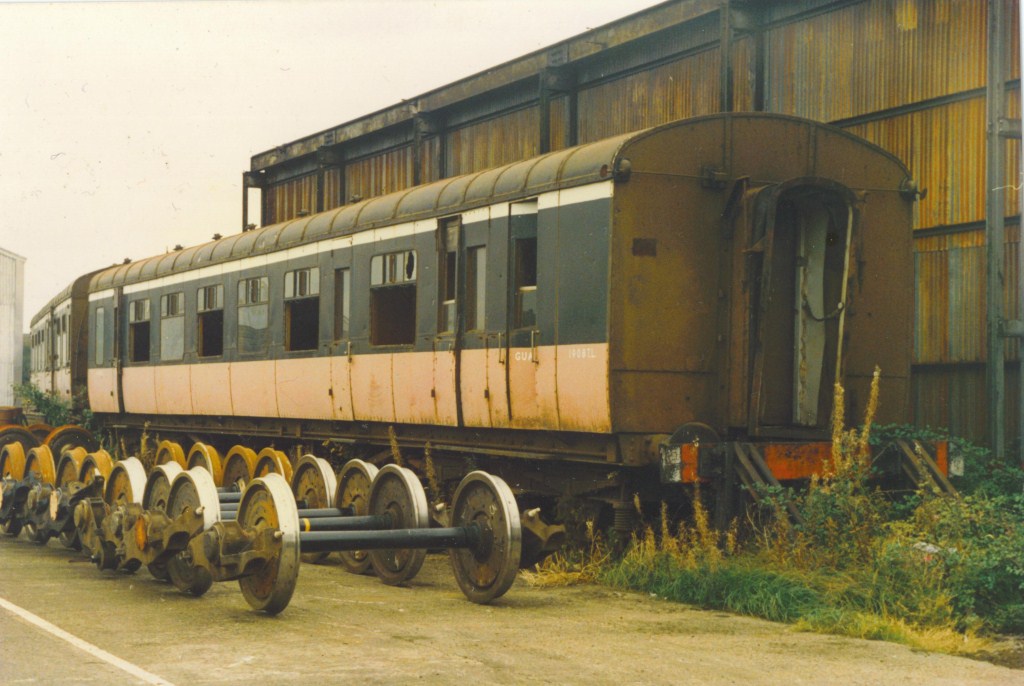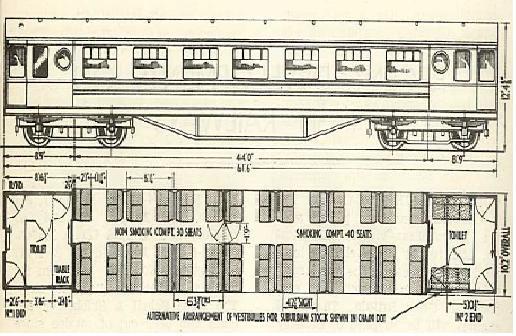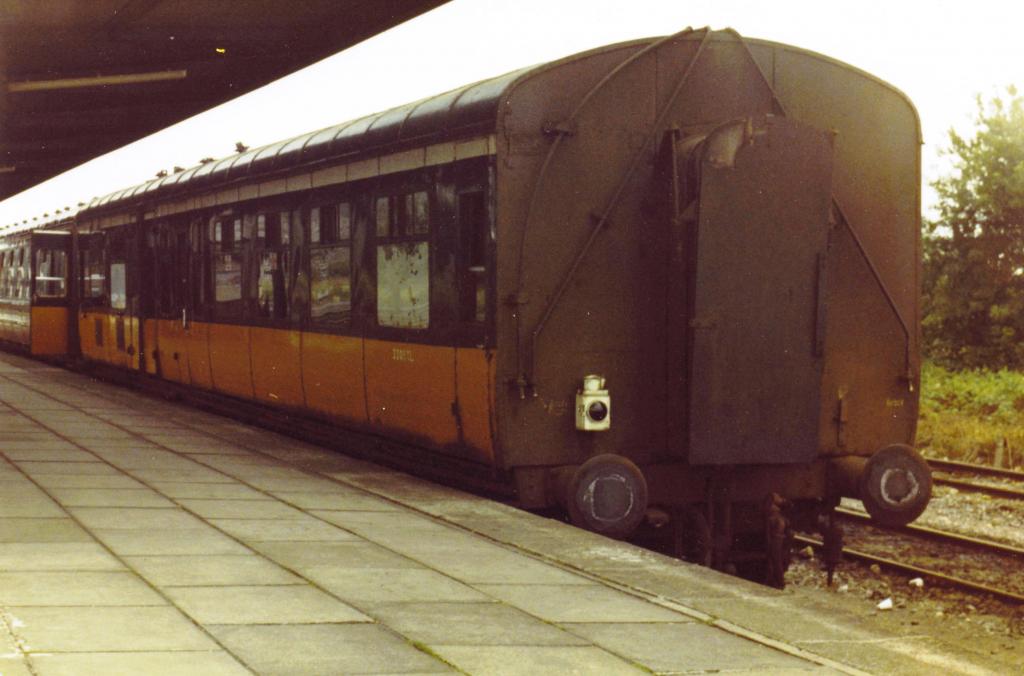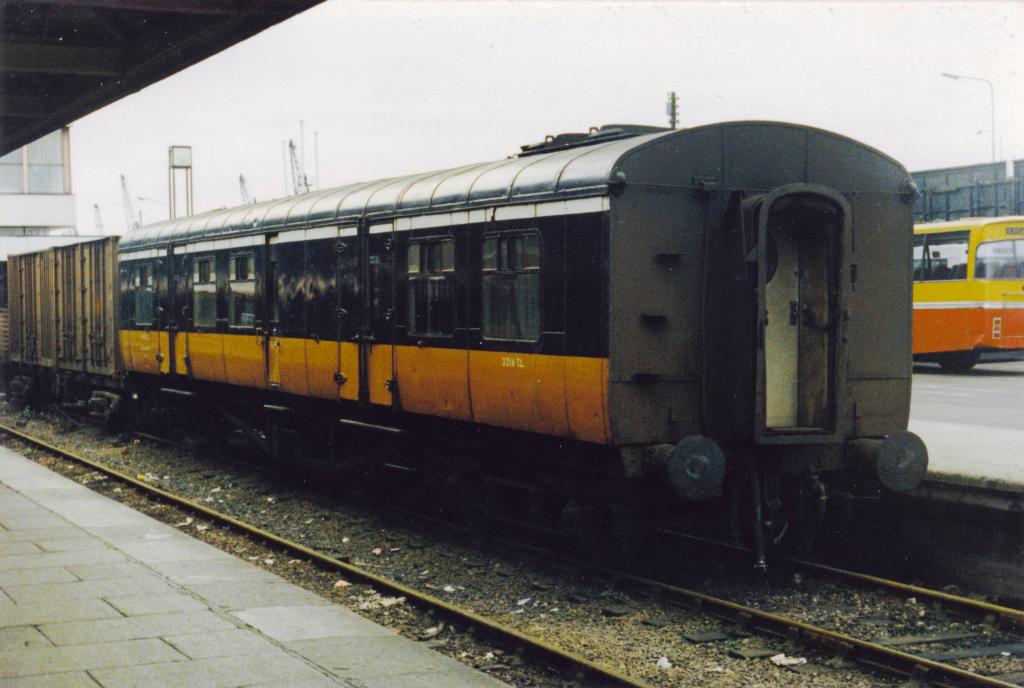
BSGSV
Members-
Posts
328 -
Joined
-
Last visited
Content Type
Profiles
Forums
Events
Gallery
Blogs
Store
Community Map
Everything posted by BSGSV
-
Bear in mind that eight vehicles (drawn from Ambulance, Snack car and "ordinary" carriages) were converted to brake standards in the 1980's, replacing CIE built stock being withdrawn at the time. These were numbered in the 194x series and one of the photos you are asking about shows one. These had a small guard's compartment at one vestible end, basically just containing a brake valve, while a toilet was re/fitted at the other end. The refit seems to have been done (if the one at Downpatrick is representative) without leaving a gap between toilet compartment and passenger area bulkhead, and what look suspiciously like CIE stock windows added (panels stripped from scrap carriages?) as per the above photo.
-
Been posted before, but perhaps worth another viewing. Would the "real" golden brown / orange please stand up...
-
25M and 27M were both allocated to the Dublin -Sligo Day Mail in 1954, so likely that they were still on that in 1956. I'm guessing they had exchange apparatus one side only? Do the two in the picture seem to be the same way around? The Amiens St picture is dated 1961 and seems very late for dark green on the last carriages. Possibly shadow from the station buildings or cloud making them seem dark?
-
Both pictures are scans from the Keith Pirt book. The Sligo one is dated as 1956. So pre-C class acting as pilot.
-
First photo: MGWR 6-wheel TPO (?), two of 1372 to 1378 series CIE timber framed compartment seconds, followed by 2405 series buffet car.
-
I finally located the one and only photo I appear to have taken of one of these carriages - 1908 seen on an IRRS visit to Inchicore on 17th September 1988. I then had trouble finding a scanner that worked. Anyhow, I'm not sure if the attached is any use, but there we are. I haven't found much of a description about the van, just: "The remaining space of the coach is taken up by the luggage and brake van; this is walled-off, but a corridor at one side gives a through passage...Double doors and a separate guard's door are provided at each side of the coach". Unfortunately, it doesn't say which side the corridor was on. With regard to duckets, as Mayner pointed out, the photos of such vehicles on the Loughrea branch show they (it?) still had duckets. 1908 has clearly lost its by the end. 1906/7 were converted to run with railcars "a driver's seat and controls were fitted in the guard's van, with a lookout window in the end". Given the thread on 1408 and the absence of comment from Mayner and josefstadt on the driver being on the "wrong" side in 1906/7, compared to 1408, this would suggest to me that the van on 1904-8 was therefore on the right (as I look at the photo of 1908). I would suggest the driver's side, at least, would have had the ducket replaced by a droplight - in order for him to communicate with platform staff without leaving his seat. 1906/7 were refitted with Commonwealth bogies, which dates the conversion to 1954 onwards. It would appear that the two were not used much and the controls "were removed in 1960; but two years afterwards they were again installed to work the Westport section of the Cu na Mara, providing access to the buffet car in the Galway section of the train; but in the summer of 1963 this express became again locomotive-hauled, and the "mules" are now redundant". The comments in parantheses are from D. Kennedy's paper to the IRRS as printed in Journal 37, June 1965.
-
Apologies. I was getting the ones with electric storage heaters mixed up. 1904 and 1442 both had them for the Ballina branch set.
-
I think the Loughrea coach was 1910, from the batch of 5 laminate brakes. Went on to the Ballina branch after closure of the Loughrea branch? I believe the two driving trailers (which didn't see a great deal of use as such) were put back on main line work and were to be seen on the Dublin Suburban in the 70's.
-
-
My attitude would be to apply one snail emblem per side, unless I had photographic evidence to the contrary. As JHB has pointed out, while there were cases of more than one per side, they were rare. Addendum: Having just flicked through Des Coakham's "Irish Broad Gauge Carriages" book, carriages with two snails on the side weren't as uncommon as I would have expected. Mind, most of them look to be older panelled carriages. CIE stock doesn't feature.
-
The number of emblems is not mentioned. However, the "Irish Rail / C.I.E. Railway Carriages" Facebook site, run by Noel Ruxton, has recently had a nice photo of three of the 1909-13 brake seconds, apparently just after completion, which have but one snail on the side. Well worth joining the site if you are interesting in coaching stock. The photo is an O'Dea one, now in the care of the NLI (stick inchicore and brake 2nd in the search and you'll find it: http://catalogue.nli.ie/Search/Results?lookfor=inchicore+brake+2nd&type=AllFields&submit=FIND
-
I posted the following in another thread on this sub-forum called Liveries, that I find hard to find now. So I decided I may as well post it again. I would also like to point out that Bredin produced but 8 carriages in his time as CME. It was his predecessor Arthur Harty who introduced flush-sided coaches on the GSR in 1935. I don't know why the generic term Bredin has come into such wide useage. Mr. D. Kennedy presented a paper to the Irish Railway Record Society which was published in their June 1965 Issue No. 37. The piece was entitled "Modern CIE Coaching Stock" and I would make it clear that coaching stock is all that is being discussed in this reply. Mr. Kennedy covered mainly the vehicles constructed by CIE and, inter alia, liveries applied. He acknowledged the assistance of Mr. Thomas Tighe of Inchicore ("Railway Tommy" well known in connection with the sadly removed railway at Malahide Castle) and Mr. Leslie Hyland of "Irish Railway News", so the credentials are good. Bear in mind the Journal in those days was monochrome, so Mr. Kennedy's word descriptions are all we have to go on, except where stated otherwise below. JHB has pointed out that CIE adopted DUTC dark green with eau-de-nil lining, with examples of the colour cited at Headhunters and No. 800 at Cultra. Mr. Kennedy describes this as "dark bottle green" and it was applied to the first CIE-built coaches, Compo's 2124-9 of March 1951, 3rd's 1339-50 of late-1951 and Compo's 2130-6 of early-1952. These do not appear to have had any lining, but did have silver windows frames and a light green "1" on first class doors. 3rd's 1351-5 of 1952 were similar to above but with the addition of a narrow light green waistband. A quote from the article: "These were the last coaches so painted, but despite a number of mid-green liveries which followed, the light green band was retained". The AEC railcars 2600 onwards started delivery in November 1951 and early members appear to have had the dark green, but not specifically mentioned by Mr. Kennedy. Delivery continued for some time, such that later members appeared in a lighter green. See a photo of 2657 at Waterford Manor in the first Tom Ferris colour album, which is standing next to a disused Clayton, still in dark green. The railcar's roof is well worth looking at too! The West Clare Railcars (286-9, later 3386-9) appeared in 1952 and also appear to have had dark green, but not mentioned by Mr. Kennedy. The fun starts with 3rd's 1356-71 and Brake-3rd's 1904-8 of 1953 which were turned out in apple green, which was according to Mr. Kennedy "most unsuccessful; within a short time the numbers were hardly legible, and the coaches were almost impossible to clean". Mr. Kennedy then goes on: "During 1953 and 1954 various other liveries, all shades of mid green, were tested on many vehicles, but all were unsuccessful". Sadly, the shades and vehicles are not mentioned, but those concerned would have been Buffets 2405-18 of 1953/4, Compo's 2137-61 of 1954 and 3rd's 1372-8 of 1954. The introduction of the new Park Royals, 3rd's 1379-1418 of 1955 introduced "Brilliant green" a lined light green which "became the standard livery for the following six years" according to Mr. Kennedy, although I have my doubts, as absence of paint seems to have been more common. This appears to be the lighter green described by JHB. The next batch of Park Royals, 1419-28 of 1956 had the same livery but with the addition of "2" on the doors, the first coaches to have them, presumably connected with the change of designation of 3rd to 2nd class on 3rd June 1956. Heating vans 3101-41 appeared in 1955/6, but were in unpainted aluminium. Buffets 2419-22 of 1956 have no livery mentioned by Mr. Kennedy - were they unpainted or green? 2nd's 1429-43 of 1956 were unpainted aluminium, complete with a red "2" on the doors. Such was the lack of wear of this finish that Mr. Kennedy notes repaints in green started in 1958... Bulleid Railcars 2660-5 of 1957 had unlined brilliant green according to Mr. Kennedy, but Compo's 2162-71, Luggage vans 2700-65 and 4-wheel TPO's 2962-71 of 1957 were unpainted aluminium, as were bogie TPO's 2972-8 and 2nd's 1444-8 of 1958. 2nd's 1449-96, produced from October 1958 to 1960 were green. Mr. Kennedy notes those produced after 1958 had a light green CIE emblem "a revival of the pre-1950 practice, which was continued until the present (sic) livery was evolved in 1961". Brake-2nd's 1909-13 of late-1959 were green too, as were Heating vans 3142-52 of 1959/60. No mention is made by Mr. Kennedy of the liveries applied to Luggage vans 2549-58 of early-1961, Kitchen 2401 of June 1961 and Compo's 2172-5 of later-1961, but this comment suggests they were green. "Shortly after the release into traffic of the 2172 class compos, several coaches appeared in a new and very striking livery of black (upper panels, roof and ends); golden brown (lower panels); and white (a band just above window level)". He duly notes new Compo's 2176-9 of 1962 as being the first new coaches in the new livery. Mr. Kennedy does not say what livery was applied to existing coaches on overhaul/repaint, but presumably the prevailing shade of green would have been used?
-
What period are you talking about regarding colour scheme? No, there's no one book. There's information scattered around the net, IRRS journals, Irish Railway News (both incarnations) and books for those who have them.
-
Re mixing Mk 2AC stock and older stock. Not an issue. All passenger stock up to Mk 3 was vacuum braked, so could work together - but the gangways of Mk 2AC were Pullman type and different from the previous British Standard gangway used. So vehicles (such as Cravens and heating vans) could be worked empty on an otherwise Mk 2AC train, say to position coaches for upcoming specials. A regular combined train was the down and up Galway Day Mail which had Mk 2AC stock for the general passenger, plus a CIE TPO and heating van for the mails and their staff. No communication between the older stock and the Mk 2 part of the train. Not the best pic but... Just got to the gates in time to photograph down Heuston - Galway day mail, hauled by 086, 4th January 1993, Woodlawn, by then reduced from a block post to a gate box. The main train is Mk2AC, but at the front is the TPO with BR van providing heat and light to the Postal workers. No connection between the two parts of the train, as the BR van and TPO have British standard gangways, the Mk2's Pullman type. All vac braked of course. While timber framed vehicles were banned by this stage from main lines, this didn't apply to the TPO. Clearly the postal workers didn't count as passengers! Note the steam rising.
-
The two Park Royals for the W&T were 1407 and 1408. 1407 was fitted with 93 bus type seats, but was otherwise not altered. When the W&T closed in 1960, 1407 was returned to work on the Dublin suburban. The driving trailer was 1408. As the photograph shows, there was a walled off driving position built into one end. The vestibule the other end was fitted out as a guard's compartment with double doors (presumably one side only?) while about half the main body of the carriage (probably the three-bay end) was partitioned off to make a space for mother & pram traffic. The remainder of the carriage seated 54 on bus type seats. On closure of the W&T, 1408 was returned to Inchicore, and remained unused until 1966 when converted to Ambulance Coach AM15. This worked on Knock Specials and the like until 1984, when it was further converted to Brake Standard 1942.
-
Generator cars for irish coaching stock - specifically HLV
BSGSV replied to Junctionmad's question in Questions & Answers
2144 built 1954. One of four of the batch of composites not on Bulleid underframe. Downgraded to all standard 1611, 1972. Converted to bogie luggage van 2572, late 1973 or early 1974. Converted to BSGSV 3223, late 1980 or early 1981. The re-instatement of the passenger accommodation was CIE's doing. When you look at the luggage van, all they did was to take out a window bay and substitute double-doors. Relatively easy to remove the doors and put back in the panel (probably salvaged from a vehicle going for scrap). When the passenger accommodation was put back in, CIE used bus type seats (giving 43 seats if memory serves). The former standard class area became the site for boiler and generator. -
Generator cars for irish coaching stock - specifically HLV
BSGSV replied to Junctionmad's question in Questions & Answers
3223 is a conversion from a Compo, not a standard. For further information on the same topic, see the six wheel heating van thread. -
In answer to various comments on this thread: C231's numerals are genuine Iarnrod Eireann, not CIE - done by the painters at Inchicore in 1996! A39's present numbers are a combination of two fonts to give a match to those in old photos of the class. Chronological order for introduction of heating vans: 4-wheel 1955, 6-wheel 1964, Dutch van 1969, BR van 1972, Brake Standard GSV (CIE conversions) 3201 to 3218 1977/8, 3219 to 3224 1980/1. 4-and 6-wheel vans were steam heaters only and did not provide electricity for TL purposes. The Dutch vans were modified in the early 1970's to provide TL power, having been steam vans only originally. The BR vans and CIE GSV conversions all produced steam and TL power. The four wheel vans survived until the 1970's. The first batch was withdrawn the year after the introduction of the BR vans and by November 1978 only 11 remained. By that stage, the CIE conversions to BSGSV had presumably taken over their duties. The series 3201 to 3218 comprised two distinct conversions. 3201 to 3212 were Brake Standard GSV, retaining passenger accommodation in compartments which remained from the original carriage. 3213 to 3218 had no passenger accommodation, but a larger luggage area instead. Both series were converted from the first 61' 6" thirds (later seconds/standards) built by CIE in 1951/2 - 1339 to 1355. Now, there were 18 GSV's, but only 17 thirds. I am guessing that a composite must have been used for the 18th GSV, but I haven't identified it yet. 3219 to 3224 were conversions of bogie vans, themselves converted from Composites originally built 1952/4. Note that all of these GSV's appear to have been converted from carriages that did not have the Bulleid triangulated underframe or Commonwealth bogies.
-
I would agree with JHB that the circular windows seemed to disappear about 1980. The fifty Park Royals comprised 40 "suburban" variant (with no toilets) and 10 "main line" variant (which had a toilet either end). Suburban were 1379 to 1418, main line 1419 to 1428. The attached block (from the Autumn 1954 IRRS Journal, but attributed to "Modern Transport" which had a feature on the Park Royals in their 31 October 1953 edition), shows the variations at the vestibule ends between the suburban and main line versions. You can ignore the incorrect bogies as all Park Royals came out on Commonwealths. Six of the main line ones got converted to "Snack Cars" in 1968 (toilet and vestibule one end given over to small counter). The survivors were reconverted back or to Brake Standards in 1984 (brake valve in the former counter area).
-
Seems cheaper, despite the tasty postage, than others on eBay recently. http://www.ebay.co.uk/itm/231381159820?_trksid=p2060778.m1438.l2649&ssPageName=STRK%3AMEBIDX%3AIT#ht_481wt_1400
-
Generator cars for irish coaching stock - specifically HLV
BSGSV replied to Junctionmad's question in Questions & Answers
1. TL (Train Lighting) is an electrical system, providing AC electric current for train lights throughout suitably equipped carriages from a vehicle equipped with a motor-alternator set (commonly called a generator van). Generally, such vehicles also provided steam heating, so were Generating (or Generator) Steam Vans, GSV. The use of AC current allowed the use of 240V AC commercially available flourescent and incandescent lamps, against the usual low voltage lamps fitted with the conventional battery + dynamo arrangement. The TL system is 3-phase. The system requires vehicles to have a connecting electrical cable between them, and full connectivity from generator van through to the end of the train to be served. As josefstadt says, if you had a mix of TL and non-TL vehicles then you needed to make sure the TL vehicles were together and coupled to the generator van, e.g. the 16:32 Connolly-Drogheda of 22/05/87 comprised 022+3217TL+1379TL+1428TL+1456+1460. As the latter pair weren't equipped for TL, they are on their own at the back of the train, allowing the two Park Royals at the front to be fed from the van behind the loco. 2. The steam vans had a boiler (or boilers) fuelled by diesel. They needed an electricity supply to pump the fuel (generally carried in underfloor tanks) to the boiler, and to control etc. the boiler (something like your domestic boiler arrangement at home). -
Generator cars for irish coaching stock - specifically HLV
BSGSV replied to Junctionmad's question in Questions & Answers
The CIE converted GSV's in the 3201 to 3218 series appear to have been used on the Limerick - Rosslare line trains (including Limerick to the Junction). An IRRS Journal article has one of the 3201-3212 series on the 16:40 Waterford - Rosslare in May 1980, as part of a survey done of carriage allocation. Slightly later are a couple of pics from the area as attached. Apologies for the scan quality, but the first is 3205 on the 14:15 Limerick to Limerick Junction after arrival at the Junction on 16/07/85 and the second is 3216 stabled at Waterford the day before. -
Generator cars for irish coaching stock - specifically HLV
BSGSV replied to Junctionmad's question in Questions & Answers
The BR vans do appear to have been equipped to provide TL from the off. Other sources say the engine produced 32.5 hp, not 21.5 as stated in IRN. Take your pick. CIE clearly intended to provide TL, even before they had coaches converted. 3189 at DCDR is now equipped with a John Deere engine, a replacement type that also appeared on other vans. -
Generator cars for irish coaching stock - specifically HLV
BSGSV replied to Junctionmad's question in Questions & Answers
WRENNEIRE's post prompted me to ponder some more, about Heating vans and Generator vans. The following extracts are from Irish Railway News. I'm not sure this clarifies anything! I don't believe that a 2-cylinder Lister is fitted to any BR vans still about - I'll have a look at 3189 tomorrow. So I'm now wondering if the BR vans were just steam only to start with. Another belief about to go? May 1972 about the new BR vans: They differ from the previous bogie heating vans, 3157-66, in having only one Spanner boiler. Power for the various fuel and water pumps and also for the combustion system is provided by a diesel-electric generator set mounted in the boiler room. It comprises a Lister 2-cylinder diesel engine giving 21.5 hp at 1,500 rpm. It is permanently coupled to a generator by BKB Electric Motors Ltd, type GP, which gives 380/220 volts AC, 25-8 amps, 3-phase current. Interior lighting is by unshaded domestic-size tungsten lamps. Aug 1972: It is reported that bogie HV 3162 has been converted to GSV. There are also persistent rumours, so far not confirmed, that the present system of axle-driven dynamos and wet cell batteries as a source of power for train lighting may be dispensed with on some of the existing coaching stock. Instead, the necessary power would be supplied from the GSV. Such a step would have many attractions due to simplified maintenance and the elimination of friction due to the dynamo belts but it is more likely that confusion has stemmed from the arrangement to heat and light the new coaches by power from diesel generator vans. -
Generator cars for irish coaching stock - specifically HLV
BSGSV replied to Junctionmad's question in Questions & Answers
I think a DV provided steam in the same way the 4-wheel heating vans did - Spanner boiler as you say. I don't think the boiler needed a "have power from a generator" per se, as it burned diesel fuel direct, but it would have had to have a control panel and pre-heat. However, I don't believe that would have provided anywhere near the power required to light a train. The Dutch vans appeared in late 1969. Shortly after the arrival of the first BR vans (January 1972) 3162 was reported in the IRRS Journal as being fitted with a diesel generator. 3158 was reported in mid 1973 with a comment that 1554 was running with it and fitted for AC (which I take to mean AC lighting and not air conditioning). The other vans mentioned in the same vein are in mid-1974 when 3164/5 were fitted and 3166 was in hands. The other vans aren't mentioned, unfortunately. I therefore am still of the opinion that the Dutch vans were steam providers only originally and were "retro-fitted" with a generator (motor-alternator would be more correct) to provide a TL supply. Listers were certainly used for TL supply, 3223 at DCDR still has a 3-cylinder Lister fitted and working.
.png.c363cdf5c3fb7955cd92a55eb6dbbae0.png)







